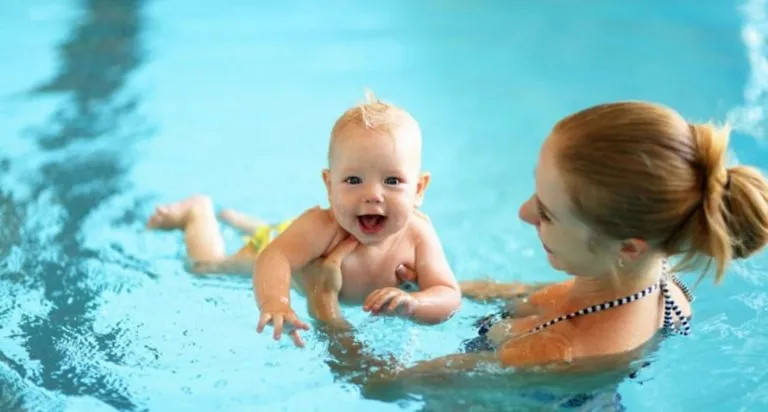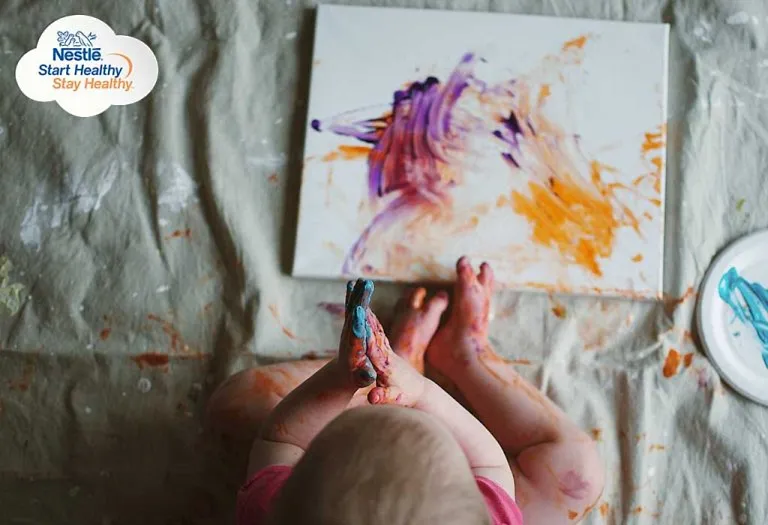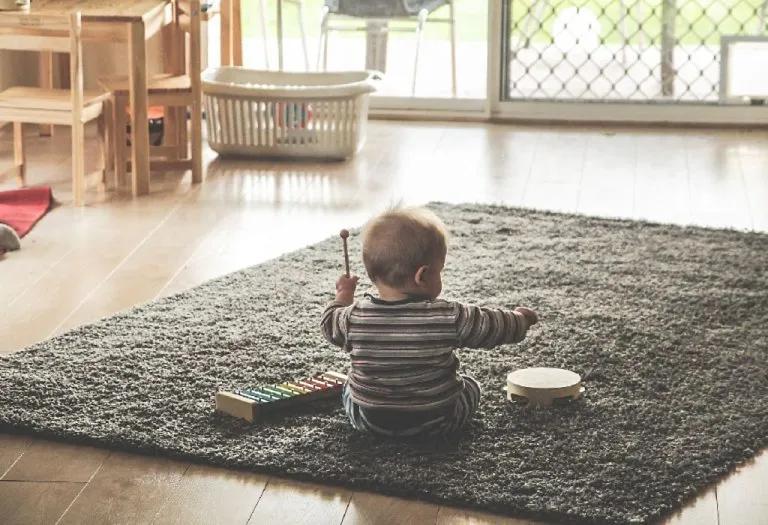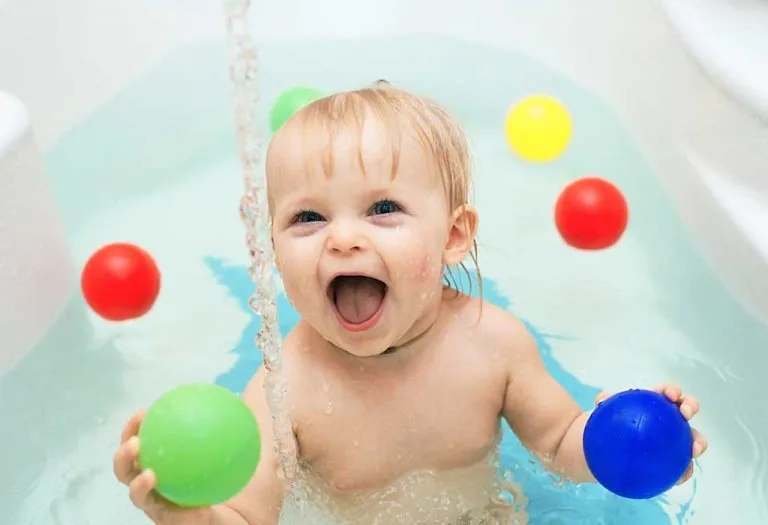Baby Swimming – When Can an Infant Go in a Pool?
The Internet is rife with captivating videos of infants who can barely hold their heads up, effortlessly performing a backstroke in the pool. These tiny prodigies are seen going completely underwater before swimming right back up to the surface with the skill of a seasoned pro. Witnessing these astonishing clips can be incredibly compelling, making any new parent eager to replicate the experience. This naturally leads to the important question of how to teach infants to swim safely and effectively. However, it is crucial to look beyond the viral content and consult professional guidelines. But is this activity truly recommended by pediatricians and child development experts? Read on to find out!
What Should be the Right Age to Take Your Baby Swimming?
The American Academy of Pediatrics (AAP) recommends that you wait until your child is 4 years old before enrolling them in swimming classes (1). This recommendation is based on the physical readiness required to be able to take swimming lessons. However, AAP does not strongly advocate against toddler swimming programs and lessons. This does not mean they recommend it, but they are tolerant of the idea.
7 Reasons to Start Baby Swimming Lessons Early
According to some studies, the earlier you start baby swimming lessons, the better it is. Here are the points in favour of early baby swimming lessons.
- Survival swimming lessons can save your baby’s life. Drowning has been estimated to be one of the leading causes of unintentional injury and/or death, especially of children aged 1 to 2 years old. Wouldn’t it be great if your baby were equipped to save himself?
- According to several studies, enrolling your baby in swimming lessons early on can reduce their risk of drowning between the ages of 1 and 4 years (2).
- The earlier you begin, the easier it is to weed out aquaphobia (fear of water). Most phobias begin during early childhood, and exposing your baby to the causative factor before such phobias have a chance to emerge could be one way to protect him from them.
- This might be a good idea for competitive swimming. Some babies, it is very clearly evident, are water babies – they love being in the water! If you have such a baby at hand and plan to get them into competitive swimming, you might be considering starting early.
- Swimming can accelerate and improve lung and heart development, increase the strength of these organs, and aid in brain development too (3). It can also greatly enhance the coordination between various body parts.
- Swimming provides your baby with necessary physical activity, which can lead to better eating and sleeping patterns, and help address issues such as low appetite and insufficient weight gain.
- Baby swimming lessons can be a unique bonding experience for baby and parent. They can also serve as an educational tool for parents to learn about water safety and life-saving skills, such as cardiopulmonary resuscitation (CPR).
However, some studies have also successfully established that a baby’s swimming age does not expedite the acquisition of swimming proficiency. Irrespective of when your baby starts taking swimming lessons, he will attain a certain degree of expertise in swimming around the same age as his counterparts (who started swimming later) – estimated to be around 5.5 years. So technically… it really doesn’t matter!
Benefits of Swimming for Infants
Swimming is a great activity for your baby. It’s fun and helps them grow stronger, learn new things, and stay safe in the water. With a teacher’s help, starting early can be good for your child in many ways, as below.
1. Boosts Brain Power
Moving and breathing in the water helps your baby’s brain grow. It can help them learn to focus, figure things out, and understand the space around them better.
2. Builds Strong Muscles
Swimming uses your baby’s whole body. The water makes it harder to move, which helps them develop important muscles in their core, neck, and back. This helps them develop stronger muscles and improves skills such as sitting and crawling.
3. Teaches Water Safety
This is a very important benefit. Babies can learn basic skills, like how to float on their back. These lessons help keep them safe around water and lower the risk of drowning.
4. Makes Them More Confident
When a baby learns to do something new in the water, it makes them feel proud and brave. This confidence can help them feel good about trying other new things, too (4).
5. Brings You Closer Together
Swimming with your baby is special because you hold them close and play together. This one-on-one time helps you build a strong bond and trust with each other.
6. Makes Heart and Lungs Healthy
Moving around in the water is good exercise. It gives your baby’s heart and lungs a workout, which helps keep them healthy and strong.
7. Helps Babies Sleep Better
Playing in the pool uses a lot of energy, and the warm water is relaxing. This often helps babies take longer and better naps after swimming (5).
8. Can Improve Eating Habits
All that swimming makes babies hungry! The activity can help them have a better appetite after their lesson and can also help their digestion (6).
How to Introduce Baby to Swimming
So, if, after all considerations, you have decided to start swimming lessons for your baby, remember: you cannot, and should not, do it alone (i.e., without a trained expert/supervisor).
It is best to look for a baby swimming program offered by a credible institute. Look for the qualifications of the experts who will actually be working with your baby. Ensure they are following regulatory guidelines to make the swimming pool and the entire experience safe for your baby.
Having said all that, it would be best not to ‘hand your baby over’, but to instead join your baby in the pool. You do not want to regret and feel sorry if you are unable to rush to your baby’s side in time, should such a situation arise.
Also, remember, any kind of swimming lesson should not be attempted until the baby has learnt to hold their head up. Your focus should be on three things when trying to teach your baby to swim:
- Teach them to float – this can be tried for younger babies.
- Teach them to roll over and put their face out of the water – this too can be tried with younger babies.
- Teach them to move to the sides of the pool – this might be suitable for slightly older babies (1 year and above).
As your child gains control over the above three movements, you may try teaching them advanced movements, maybe even a stroke.
- Never carry your baby down the steps and into the water. Always put the baby on a mat (by the edge of the pool), enter the pool yourself, and then pick up your baby, as shown in the video.
- Never allow anyone to hand your baby over to you while you are in the water; the risk of the baby being accidentally dropped into the water is too high.
- The first activity you can try is ‘swings and dips’; you hold the baby with their back facing the water and swing them from side to side. If your baby seems keen, you may try to dip his ears in the water (so he can get used to the difference in pressure).
- Next, you can try ‘breathing activities; this is a demonstration-only activity where you hold the baby in front of you, and show them how to take a deep breath (out in the air), and release it under water to make bubbles. With time, your baby may show a willingness to try it on his own.
- The next activity you can try is ‘kicking legs in the water.’ Hold your baby close to you, supporting their head and neck, and gently splash their legs up and down in the water (as shown in the video). Similarly, you can even try ‘splashing hands in the water’.
- The next activity is ‘walk floating’; hold your baby with their tummy touching the water, head supported and held above water level. Slowly walk backwards, dragging the baby forward with you. You may notice your baby kicking his legs and hands (if your baby learned the previous activity)! The same activity can also be tried by holding the baby on their back. After sufficient practice, you can try giving your baby more freedom by supporting only their head, letting their waist, bottom, and limbs be free to move and wiggle as they please.
- Finally, while coming out of the pool, follow the same practice as getting into the pool: place the baby on the mat, step out of the pool, then pick your baby up.
8 Swimming Safety Tips
Here are important safety concerns, so far as taking baby swimming is considered (7).
- Learn about CPR. Cardiopulmonary resuscitation – or CPR – is a way of reviving an unconscious person, commonly one who has been a victim of drowning. It is a complex procedure that involves reviving a heart that has temporarily stopped beating, and ventilating a person artificially (i.e., helping their body get ‘air’ so that they can get oxygen and remain alive). Knowing CPR can prevent a dangerous situation from escalating, and if you are taking your baby anywhere near a swimming pool, you should know CPR.
- Swim in proper gear. Swimming gear – including swimsuits, caps, goggles, and earplugs – is essential for a safe and comfortable swimming experience.
- Floats are a must. Once in the pool, it should be imperative for children to use floats until they master swimming. The best kinds are inflated tubes that go around the waist. If not, life jackets are another option.
- Beware of pool-borne infections. Swimming pools are ideal breeding grounds for various types of germs. So beware of pool-borne infections and take due precautions. The swimming gear mentioned above will also help keep infections far away from your child. If required, ask your paediatrician for preventive measures, and also seek him/her out at the earliest sign of things going wrong – rashes, redness, any kind of discharge (from eyes, ears, etc.) should be taken seriously.
- Also, beware of hypothermia. The temperature of the water in the pool has to suit your baby. Remember, babies cannot effectively self-regulate their body temperature, and extreme temperature differences can cause them to go into shock, a condition known as hypothermia.
- Instill discipline. This pertains to toddlers and older kids. Instill a strict code of discipline for being in and around a swimming pool: no playing pranks, no pushing anyone into the water, no splashing or diving, and certainly no dares! While swimming pools can be enjoyable, they need to be treated with caution!
- Supervision is a must. No matter how old your kids get, never let them be around a pool without adult supervision. Also, make sure the adult supervising your child knows how to swim and will be able to intervene constructively and in a timely fashion should an accident occur.
- Don’t push too hard. While you may want your baby to start early, pay heed to any signs of discomfort, hesitance, or unwillingness your baby may be displaying.
6 Ideas to Help Your Baby Enjoy Swimming
Here are some tips on making swimming time fun and enjoyable for your little munchkin!
- Involve them in the shopping process. Even babies have preferences for colours, patterns, etc. If you can involve them in the shopping for their sippy cup, first spoon and plate, clothes and toys, why not their swim gear too?
- Jump in with them. One of the easiest ways to comfort your babies in the pool is to jump right in with them. If you are afraid of entering a pool, remember that you will be taking your baby to a ‘baby pool’, in which the water won’t be above the waistline. It will indeed be reassuring for your baby to be only at arm’s length from you, and might actually excite them to try it!
- Maintain eye contact and keep smiling. This will make your baby feel safe. You may sing to them or praise them to encourage them to move about independently in the water.
- Carry their favourite toy along. Toys always soothe babies, so make sure you carry their favourite toy to the pool. For older children, you can use toys to motivate them to swim.
- Click pictures. The younger generation is definitely more camera-friendly than the older one used to be when they were kids. So one way to try and make the experience of taking your baby swimming a more enjoyable and memorable one is to also take your camera or simply your phone along, and have someone take pictures. (Beware of dropping the camera/phone in the pool, though!)
- Reward them. Who doesn’t love gratification? For a successful time in the pool, you can reward your baby with a new toy, their favourite food or snack, or maybe just a nice and warm cuddle session!
What to Carry in Your Baby’s Swim Bag
When you take your baby swimming, you’ve got to be prepared for any situation that may arise! Consider adding the following things to your baby’s swimming bag (8).
- First aid
- Swim gear
- Extra diapers
- All diaper-bag essentials
- Toiletries and bathing essentials (including soap, wipes, shampoo, towel, disinfectant, etc.)
- Fresh set of clothes
- Accessories (like toys, floats, etc.)
- Snacks (for after the swim)
- A familiar lovey or small toy
- Spare bags or ziplock bags.
How to Pick the Right Swimming Class for Your Baby
Choosing your baby’s first swimming class is an important decision that can shape their relationship with water. The right class should be safe, fun, and supportive. Here are the key factors to consider to ensure you find the perfect fit.
- Certified Instructors: Ensure they are certified in infant aquatics and infant CPR/First Aid.
- Warm Water: The pool must be heated, ideally between 30-33°C (86-92°F).
- Small Class Size: Look for a low ratio (e.g., 1 instructor to 6-8 babies) for individual attention.
- Gentle Approach: Choose a class that focuses on fun and comfort, not forced submersion.
- Clean Facility: The pool should be clean and use a mild chlorine or saltwater system.
- Observe First: Watch a class to see if the vibe is calm, happy, and well-organized.
- Trust Your Gut: You and your baby should feel safe and comfortable.
FAQs
1. Can swimming in chlorinated pools trigger or worsen infant eczema?
Yes, it can be a concern for babies with sensitive skin or a predisposition to eczema. Chlorine is a drying agent that can strip the skin of its natural oils, leading to irritation. However, many modern pools use milder sanitation systems like saltwater or ozone. To mitigate risk, choose a facility with these options, rinse your baby with fresh water immediately after class, and apply a gentle, fragrance-free moisturizer to lock in hydration.
2. My baby has frequent ear infections. Should we avoid swimming?
Not necessarily. While middle ear infections (otitis media) are not caused by water in the ear canal, doctors often advise against swimming while an infection is active due to fever and discomfort. For preventing outer ear infections (swimmer’s ear), which are caused by bacteria in moist environments, simply drying your baby’s ears thoroughly after swimming with a towel is usually sufficient. Avoid using cotton swabs inside the ear canal.
3. How soon after immunizations can my baby go swimming?
There is no medical need to wait after routine childhood vaccinations. You can take your baby swimming as soon as you and they feel well enough, even on the same day. The small injection site is sealed within minutes, posing no increased risk of infection from a clean, well-maintained pool. The old advice to wait 24-48 hours is outdated unless your baby has a specific reaction, like a fever, or appears unusually fussy and uncomfortable.
Swimming is a skill that your baby will never forget once he learns it. It is like driving a car, or writing – no matter how little you do it on a daily basis, you never really forget. Swimming is a great way to unwind, and can be used for recreation too! All the best!
Also Read:
Drowning in Children
How to Teach Kids to Swim
Water Play for Babies and Toddlers
Was This Article Helpful?
Parenting is a huge responsibility, for you as a caregiver, but also for us as a parenting content platform. We understand that and take our responsibility of creating credible content seriously. FirstCry Parenting articles are written and published only after extensive research using factually sound references to deliver quality content that is accurate, validated by experts, and completely reliable. To understand how we go about creating content that is credible, read our editorial policy here.






















